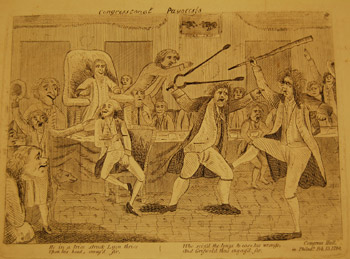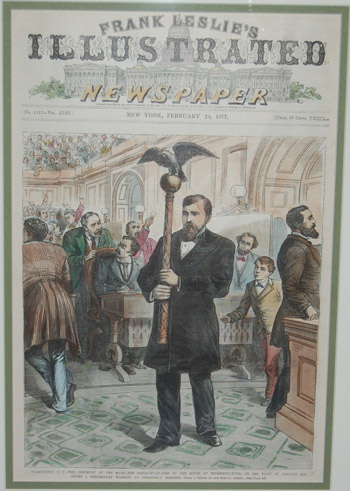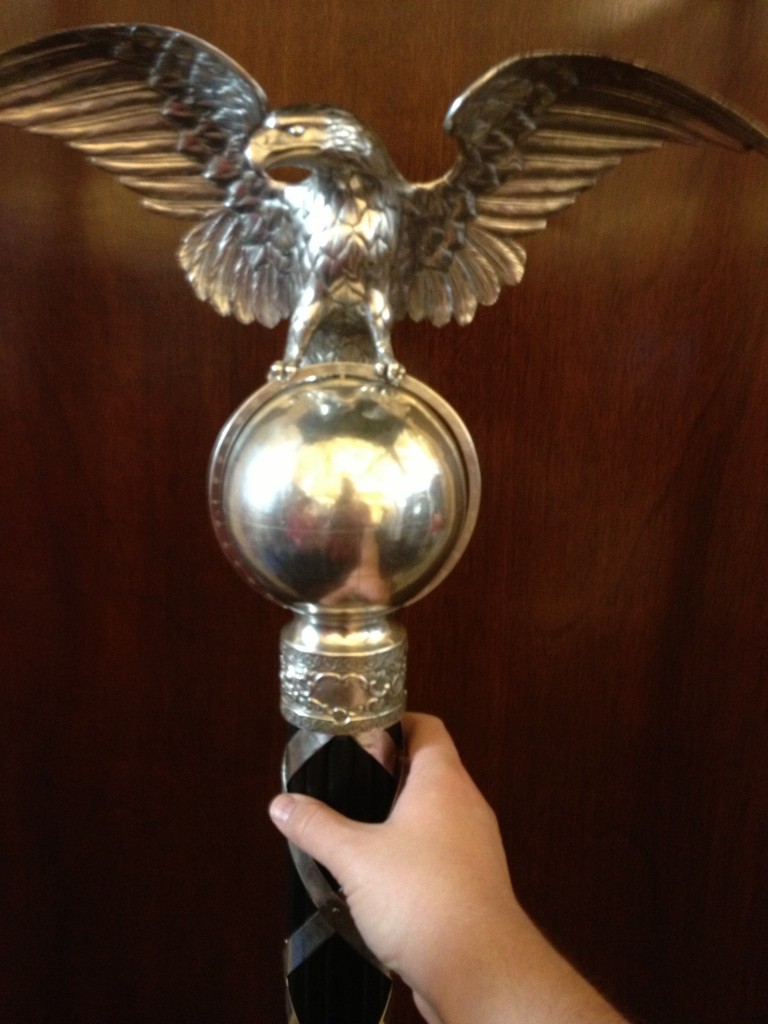There are few things I find more fascinating than medieval weapons and their use in our current government structure, even if they are ceremonial. The Mace as used as a symbol of authority in government has a long history that derives from Medieval Europe. Commanders during the era of heavy armour would task a Sergeant-at-arms with bearing their ceremonial mace into battle.
 Here is the Dark Lord Sauron, pictured with his Mace.
Here is the Dark Lord Sauron, pictured with his Mace.After maces grew unpopular and impractical as a weapon for combat (since it would take someone the likes of Sauron to do damage with it) the idea of a civic mace took hold. The Sergeant-at-arms of a given body of representatives would carry their own ornate ceremonial mace as a figurehead for their duties. Many countries around the world use these maces, but some are surprised to find that the United States uses one as well. As one of the first resolutions by the first Congress of the United States (in 1789), an office of the Sergeant-at-arms was established and soon after a ceremonial mace was ordered for him to carry out his duties. The Mace of the U.S. House of Representatives is the symbol of authority of the House and you can always tell when the House is in session because the mace will be resting on a green marble pedestal next to the Speaker’s desk. When not in use, it’s housed in the Sergeant-at-Arms’ office. It’s also used to bring order to the house. Though it seems like something you’d see more in British Parliament, if a member is out of order, the Sergeant-at-Arms will take the Mace off its pedestal and present it to the member to restore order. It happens so infrequently and is such a powerful symbol, the idea of the Mace being used in such a way is supposed to put things back in order immediately. If it doesn’t work, members could very well be arrested.
 Congressional Pugilists (1798)
Congressional Pugilists (1798)The first recorded presentation of the Mace to unruly members was in Congress Hall in Philadelphia in 1798. We thought our politics today were divided, but on this January day a fight broke out between two congressmen. Roger Griswold, a Federalist from Connecticut, insulted Vermont Democrat Matthew Lyon, who, for the insult, spit in the first man’s face. Griswold responded by attacking Lyon with his cane at the next meeting, to which Lyon responded by retrieving a pair of tongs from the fireplace to retaliate. The Mace was presented, order restored, neither member was expelled, and business carried on. There have been three Maces of the House of Representatives. The first was in use from the beginning of the country until The War of 1812. The British invaded the District of Columbia, burning the White House and the Capitol and one of the artifacts lost forever was the original Mace of the U.S. House of Representatives. A wooden substitute was used until the current Mace was commissioned, built, and then put into use by 1841. Though there aren’t any representations today of the original Mace, it’s said that this Mace was commissioned to be like the original.
 The Mace in an engraving from 1877.
The Mace in an engraving from 1877.The current mace is definitely not the sort of thing you would take in battle, much more ceremonial and symbolic than anything. It’s made of 13 ebony rods, representing the original colonies, bound together in intertwining silver bands and culminating in a headpiece that consists of a silver globe etched with the world, United States front and center, and a solid silver eagle.
 The current Mace
The current MaceAs the symbol for authority for the House of Representatives, it is presented before their procession at presidential inaugurations, and is held and presented throughout the ceremony by the Sergeant-at-Arms or his deputy. It’s this really cool piece of often overlooked bit of American history that’s still in use that should be fascinating to everyone. Here’s this thing that’s been present during the ascension of every president since John Tyler, in every session of Congress through the Civil War and today, and carries on. I’m told that it literally takes an act of congress to have it cleaned since it’s so delicate and the Smithsonian is charged with the task. Because of the difficulty of the preservation and the need for it to be present in Congress, it’s only been cleaned three times in all of those years.
 You’ll notice the Mace on the left on the green marble podium.
You’ll notice the Mace on the left on the green marble podium.If ever you visit the House of Representatives, there you will see it sitting there if the House is in session, watching over the proceedings and waiting to deliver a symbolic beat-down if order is disrupted. And if you’re very lucky, you might even get to see it up close.
 Swank, touching the Mace.
Swank, touching the Mace.Maybe this isn’t geeky enough for you, but I found the idea that United States has a ceremonial version of a medieval bludgeoning weapon constantly in use and on display endlessly geeky and fascinating. (More info on the Mace can be found here.) And be sure to check out more installments of The History Geek here!